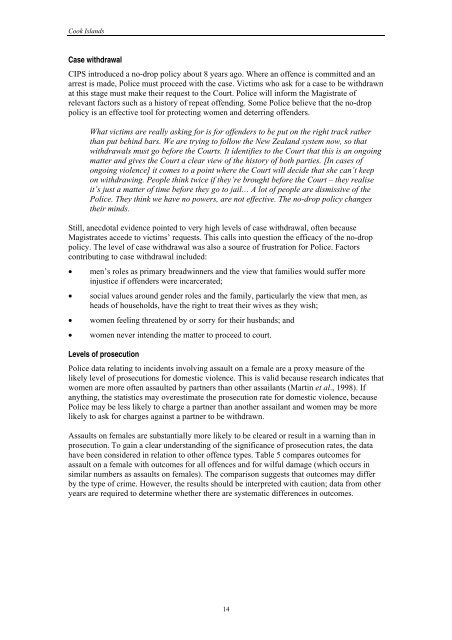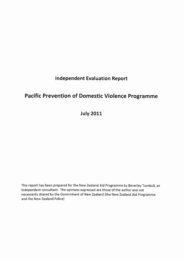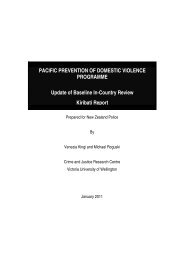Cook Islands - Pacific Prevention of Domestic Violence Programme
Cook Islands - Pacific Prevention of Domestic Violence Programme
Cook Islands - Pacific Prevention of Domestic Violence Programme
You also want an ePaper? Increase the reach of your titles
YUMPU automatically turns print PDFs into web optimized ePapers that Google loves.
<strong>Cook</strong> <strong>Islands</strong><br />
Case withdrawal<br />
CIPS introduced a no-drop policy about 8 years ago. Where an <strong>of</strong>fence is committed and an<br />
arrest is made, Police must proceed with the case. Victims who ask for a case to be withdrawn<br />
at this stage must make their request to the Court. Police will inform the Magistrate <strong>of</strong><br />
relevant factors such as a history <strong>of</strong> repeat <strong>of</strong>fending. Some Police believe that the no-drop<br />
policy is an effective tool for protecting women and deterring <strong>of</strong>fenders.<br />
What victims are really asking for is for <strong>of</strong>fenders to be put on the right track rather<br />
than put behind bars. We are trying to follow the New Zealand system now, so that<br />
withdrawals must go before the Courts. It identifies to the Court that this is an ongoing<br />
matter and gives the Court a clear view <strong>of</strong> the history <strong>of</strong> both parties. [In cases <strong>of</strong><br />
ongoing violence] it comes to a point where the Court will decide that she can’t keep<br />
on withdrawing. People think twice if they’re brought before the Court – they realise<br />
it’s just a matter <strong>of</strong> time before they go to jail… A lot <strong>of</strong> people are dismissive <strong>of</strong> the<br />
Police. They think we have no powers, are not effective. The no-drop policy changes<br />
their minds.<br />
Still, anecdotal evidence pointed to very high levels <strong>of</strong> case withdrawal, <strong>of</strong>ten because<br />
Magistrates accede to victims’ requests. This calls into question the efficacy <strong>of</strong> the no-drop<br />
policy. The level <strong>of</strong> case withdrawal was also a source <strong>of</strong> frustration for Police. Factors<br />
contributing to case withdrawal included:<br />
• men’s roles as primary breadwinners and the view that families would suffer more<br />
injustice if <strong>of</strong>fenders were incarcerated;<br />
• social values around gender roles and the family, particularly the view that men, as<br />
heads <strong>of</strong> households, have the right to treat their wives as they wish;<br />
• women feeling threatened by or sorry for their husbands; and<br />
• women never intending the matter to proceed to court.<br />
Levels <strong>of</strong> prosecution<br />
Police data relating to incidents involving assault on a female are a proxy measure <strong>of</strong> the<br />
likely level <strong>of</strong> prosecutions for domestic violence. This is valid because research indicates that<br />
women are more <strong>of</strong>ten assaulted by partners than other assailants (Martin et al., 1998). If<br />
anything, the statistics may overestimate the prosecution rate for domestic violence, because<br />
Police may be less likely to charge a partner than another assailant and women may be more<br />
likely to ask for charges against a partner to be withdrawn.<br />
Assaults on females are substantially more likely to be cleared or result in a warning than in<br />
prosecution. To gain a clear understanding <strong>of</strong> the significance <strong>of</strong> prosecution rates, the data<br />
have been considered in relation to other <strong>of</strong>fence types. Table 5 compares outcomes for<br />
assault on a female with outcomes for all <strong>of</strong>fences and for wilful damage (which occurs in<br />
similar numbers as assaults on females). The comparison suggests that outcomes may differ<br />
by the type <strong>of</strong> crime. However, the results should be interpreted with caution; data from other<br />
years are required to determine whether there are systematic differences in outcomes.<br />
14














